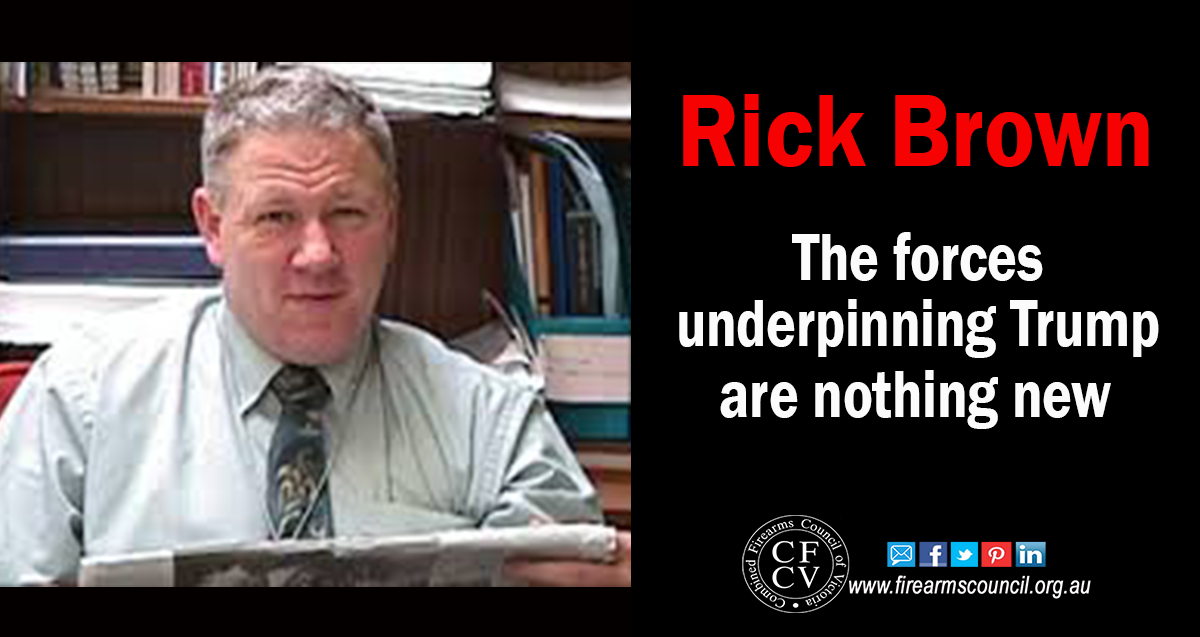 Rick Brown is a political strategist who has served the shooting industry well for many years. His advice has been pivotal in helping the Victorian shooting industry navigate the political waters and secure many of the wins we’ve had over the past few years.
Rick Brown is a political strategist who has served the shooting industry well for many years. His advice has been pivotal in helping the Victorian shooting industry navigate the political waters and secure many of the wins we’ve had over the past few years.
He wrote the article below for On Line Opinion, which we reproduce here for you. His article provides a deeper understanding of how people have, for many years, turned their backs on ‘the political elite’ when they take people for granted.
The forces underpinning Trump are nothing new
Australian political commentators and self-proclaimed experts who have been traumatized or shocked by Donald Trump’s victory could well be accused of incompetence or ignorance.
Of all people, those Australians who take a keen interest in politics should have been the least surprised by the revolt of America’s blue collar workers and the inability of inner suburban elites in New York and Washington (with a few notable exceptions) to comprehend, let alone understand, the values and concerns of outer suburban and regional residents.
In the 2004 federal elections John Howard ignored his advisers and opted to support timber industry jobs rather than the forests agenda of the inner suburban elites in Sydney, Melbourne and Perth.
On the other hand, Mark Latham ignored his own cultural analysis and went with the inner suburban elites. The result was Mark Latham’s running away from timber workers in Hobart and John Howard’s addressing a timber industry rally in Launceston in the last week of the campaign.
Those images determined the size of the Coalition’s majority if not the result of the elections.
In 2005 the timber workers’ union commissioned The Brompton Report, a social and cultural analysis of those elections. That analysis about the incompatibility of the values of inner metropolitan suburbs and the outer suburbs and regional areas and the consequences of alienating blue collar workers was news neither of the major parties wanted to hear.
Notwithstanding Bill Shorten’s union experience it is obvious he has not read it and probably does not even know it exists.
Labor’s response was to pretend the analysis did not exist and to ignore it. The Liberals also ignored it and continued preferencing Greens ahead of Labor, which they did ironically or hypocritically, depending on one’s point of view, in the 2004 elections, until external pressure forced the Liberals in Victoria to preference the Greens last in the 2010 elections. That decision determined the outcome of those elections.
That analysis dealt in some detail with the reasons for the transformation of the South in the USA from blue (Democrat) to red (Republican) and the role played by religion.
The Brompton Report, which On Line Opinion posted at the time, is as relevant now as it was then.
An even clearer forerunner of Brexit and Mr. Trump’s ascendancy was the 1999 referendum on the republic. Again the elites (which included the majority of politicians – not unlike the Brexit vote and the opposition to Mr. Trump) refused to analyse its implications because they were on the losing side.
The fact that this includes the current prime minister, Malcolm Turnbull, then the leader of the republican movement, is not without its ironies. Had he done so the position in which he now finds himself may well have been different.
In Queensland only two electorates, Brisbane (then Labor) and Ryan (Liberal) voted in favour of a republic. In Victoria Melbourne and Melbourne Ports (both then Labor) and Higgins and Kooyong (both Liberal) had the highest Yes votes.
Labor seats in Melbourne’s western suburbs recorded similar No votes to Liberal seats on Melbourne’s eastern fringe.
A similar analysis can be done of the results in New South Wales in particular.
The votes reflected geography – not party allegiance. The further from the GPOs of state capital cities the higher the No vote was. Canberra does not require a comment.
It is interesting to compare maps of the US presidential vote on a county basis with the Brexit vote and both with the referendum vote.
They are all the same. Hillary Clinton’s vote came from New York, Washington, Los Angeles, San Francisco, Salem, Seattle and a few large cities sprinkled across the mid-West.
In the United Kingdom, the further from the London business district the higher the vote in England and Wales to leave the European Union.
Even the vote to remain in the EU in Scotland and Ireland is easily explained. The Scots and Irish thought that government from Brussels was less threatening than government from London.
The surprise is not the facts that mainstream America rose up against the elites and that Donald Trump trounced them both in the Republican primaries and subsequently the presidential elections.
The surprise is that it took so long for this to happen.
Rick Brown is a director of CPI Strategic
www.cpistrategic.com.au

Rick Brown seems to know what’s what.
Just as well…I don’t.
Ern: you’re not alone !
And, Yes, I’m grateful for Rick’s helpful analysis.
Shorty, in Darwin